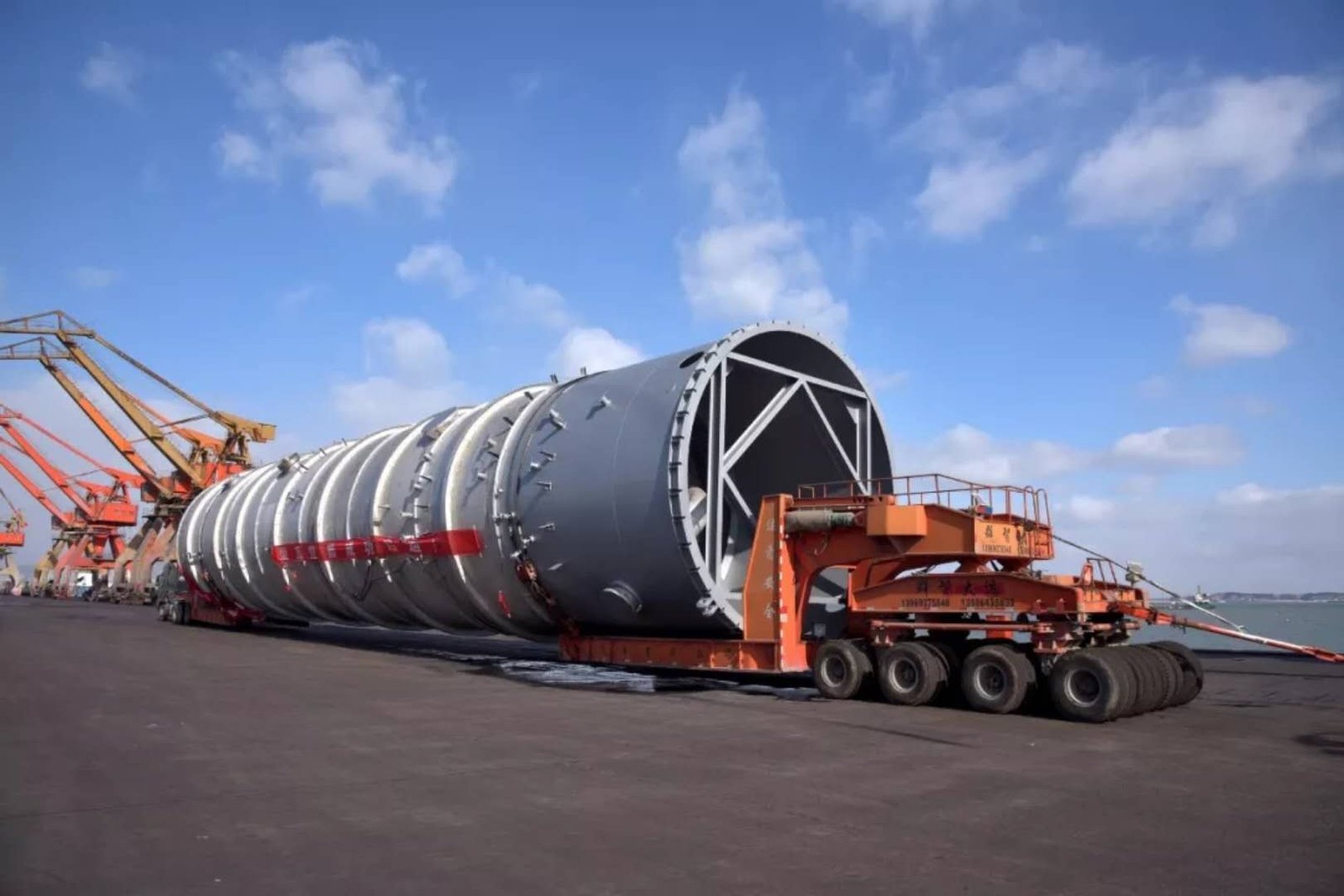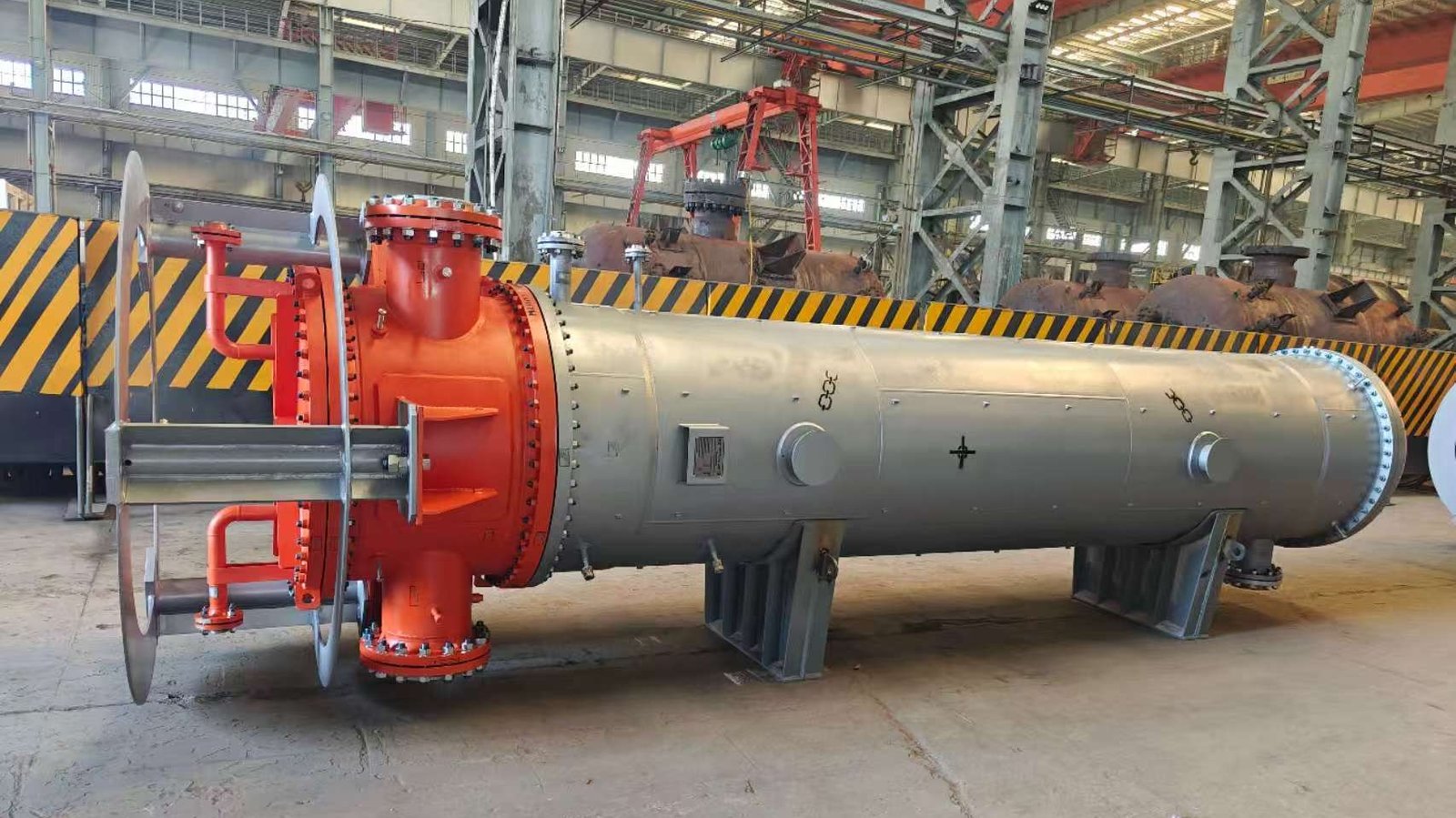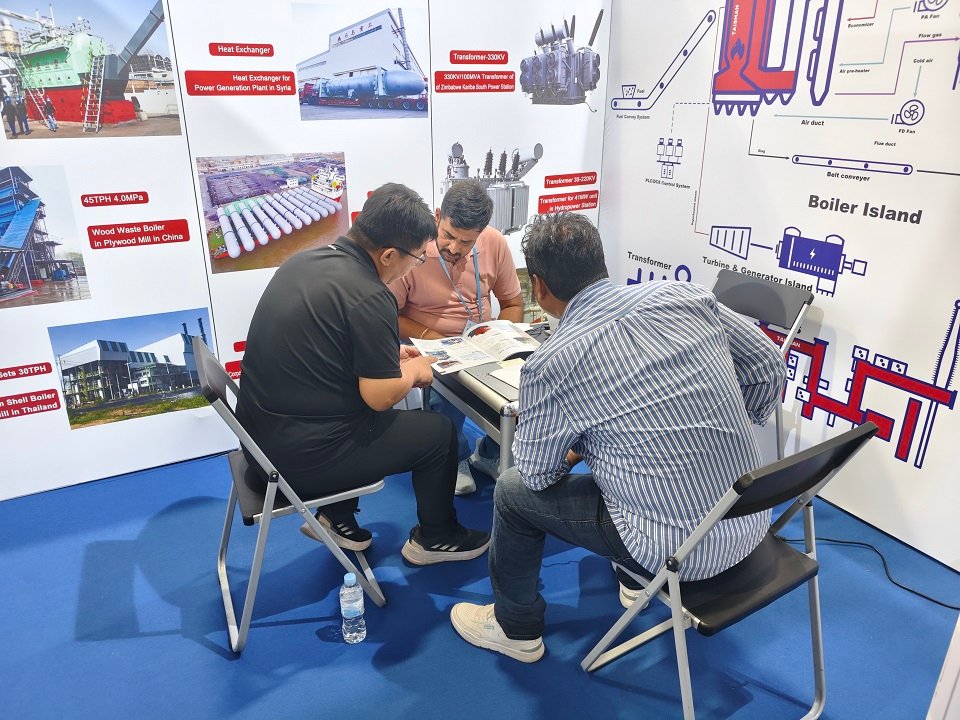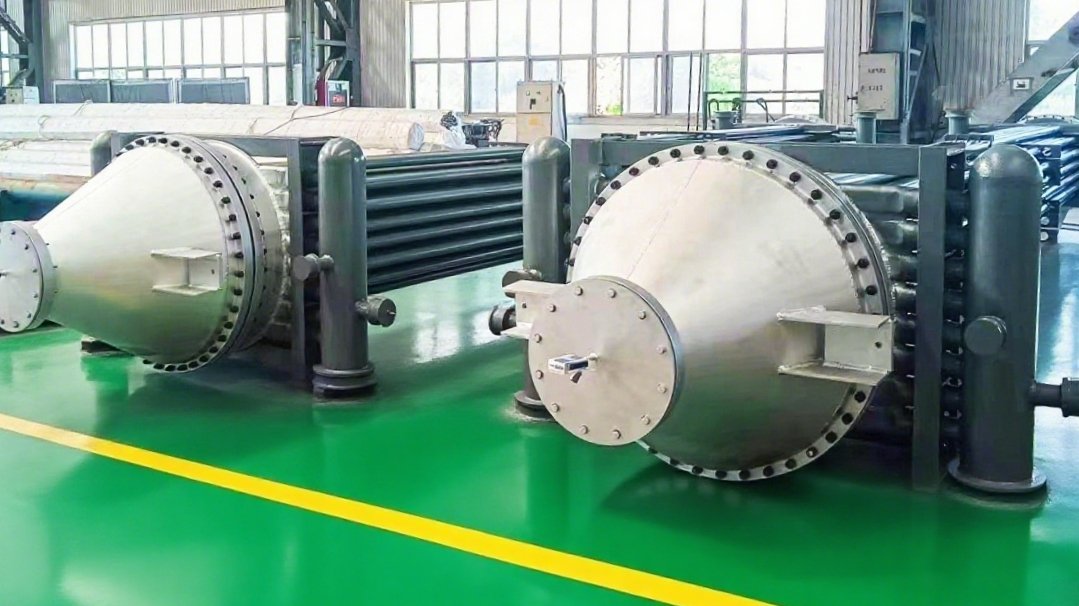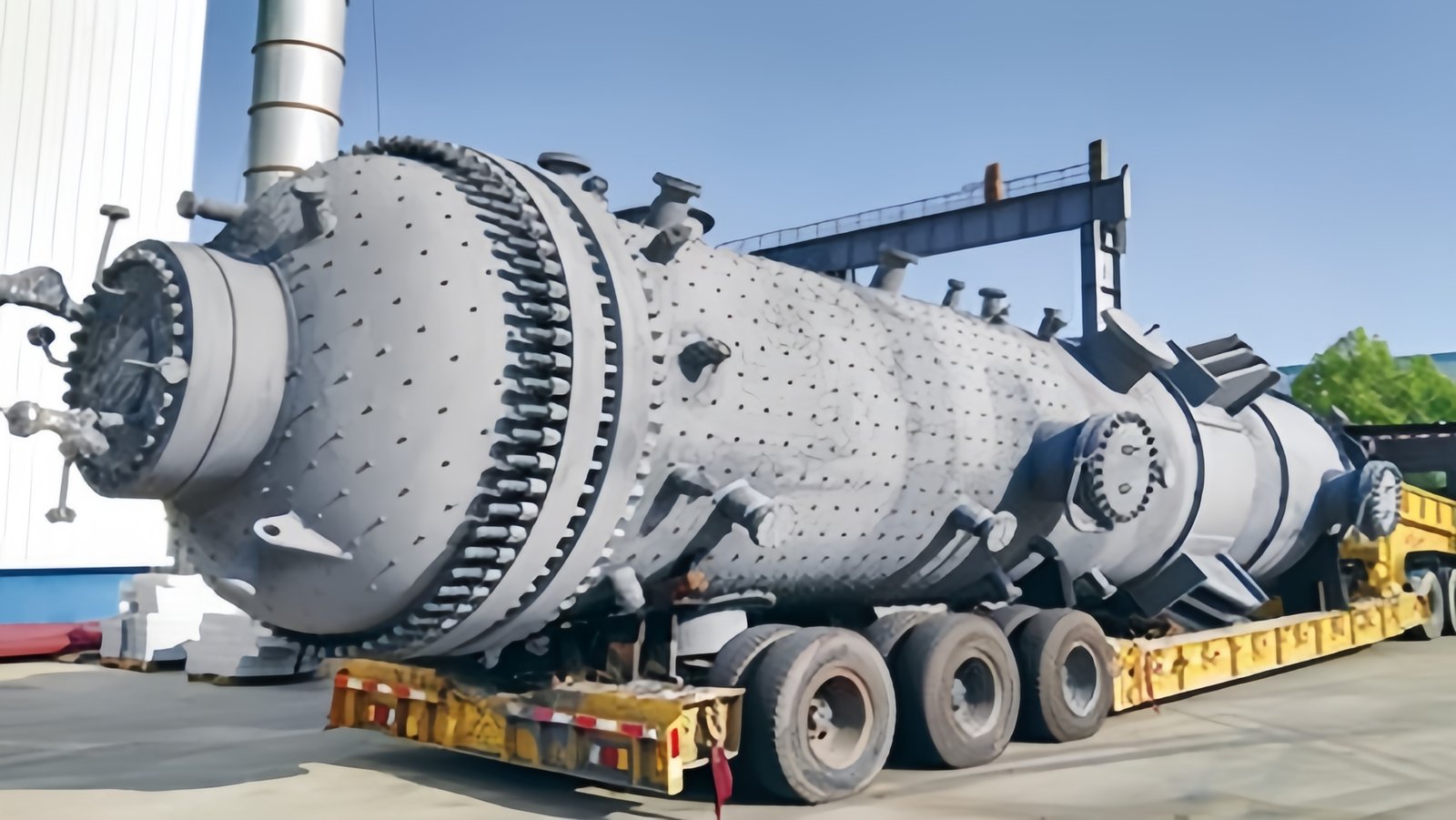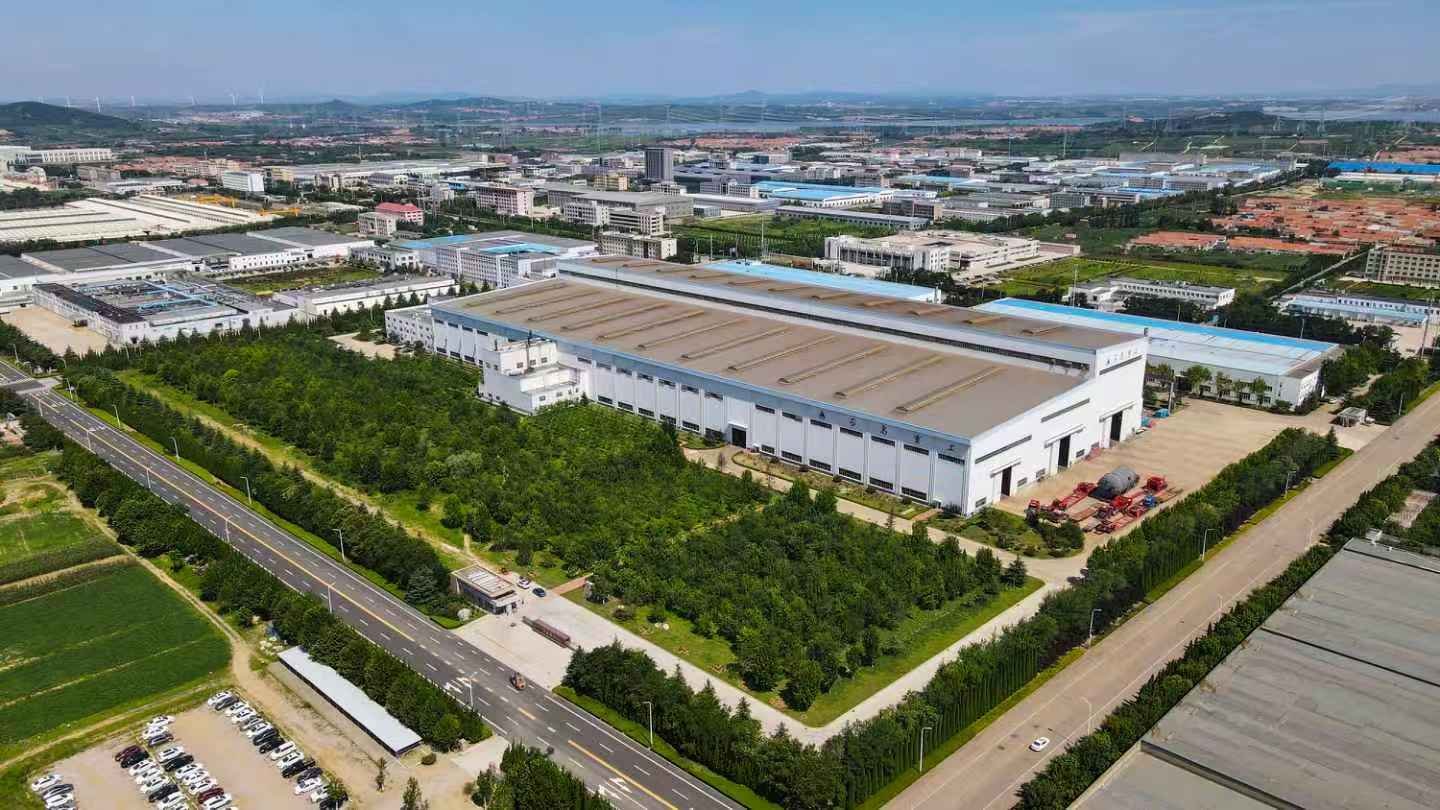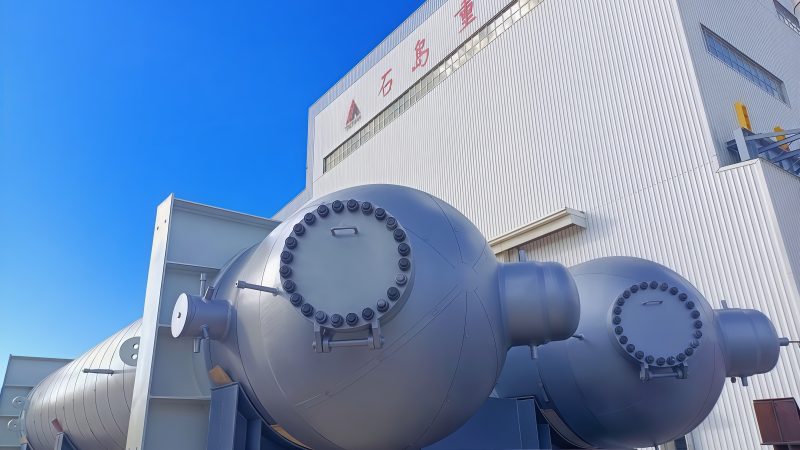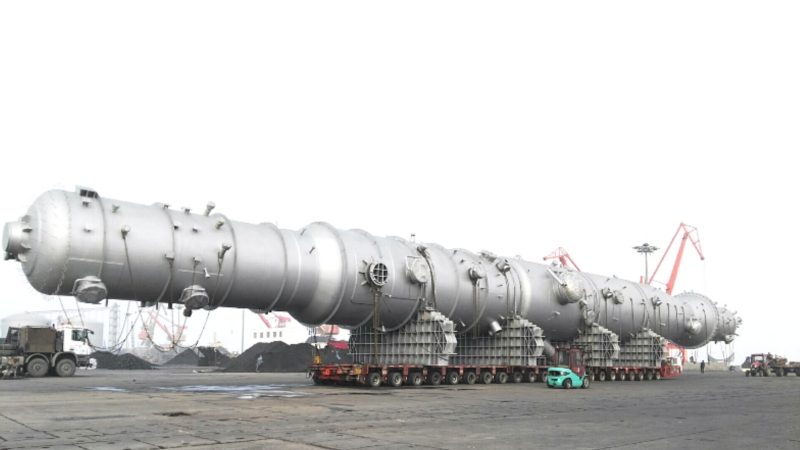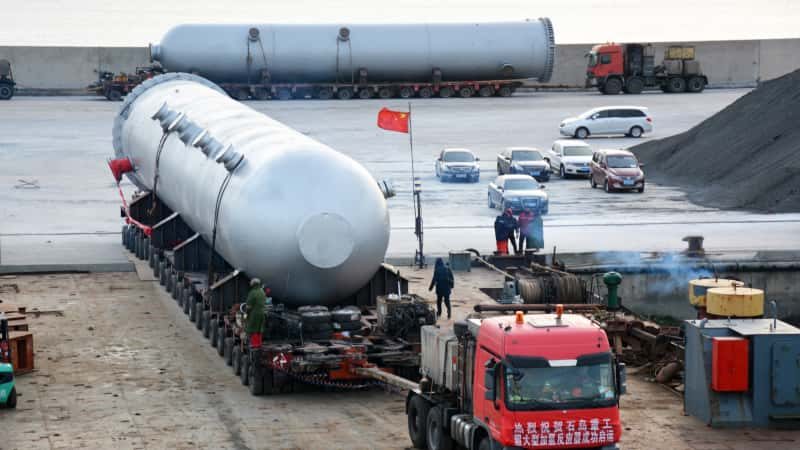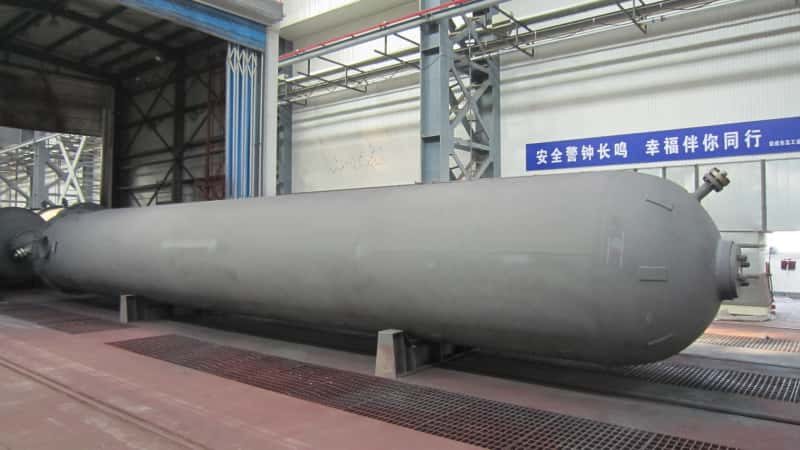In many industrial sectors—such as petrochemical, pharmaceutical, and fine chemical manufacturing—liquid-liquid extraction plays a key role in purification and separation. However, users often encounter confusion when searching for equipment like “extraction tower” or “extraction column,” not realizing they refer to the same product. This misunderstanding can delay procurement and lead to inefficient decision-making. Choosing a high-quality extraction tower & column is crucial to ensuring efficient mass transfer, stable operation, and reduced operating costs.
An extraction tower & column is a vertical vessel used in liquid-liquid extraction processes, designed to separate two immiscible liquids by promoting efficient mass transfer between phases. Whether referred to as an extraction tower or extraction column, the equipment performs the same core function—enhancing phase contact through internal structures like trays, packing, or mechanical agitators. It is widely used for continuous separation processes in large-scale chemical production.
Understanding the working principle, structural features, and application scenarios of an extraction tower & column can help you select the right system and improve your plant’s performance. Continue reading to explore how this equipment works and why it’s a vital component in industrial separation.
What Is an Extraction Tower & Column Used for in Industrial Processes?

In industrial chemical plants and processing facilities, one of the most persistent challenges is effectively separating mixtures of liquid compounds that are not easily isolated through distillation due to close boiling points or thermal sensitivity. Failing to achieve efficient separation leads to impure products, higher operating costs, increased solvent losses, and environmental concerns. Fortunately, extraction towers and extraction columns offer a technically reliable and economically viable solution for separating such complex mixtures. Understanding their operation, structure, and role in processing is essential for engineers, plant managers, and procurement teams aiming to optimize throughput and product purity.
An extraction tower or extraction column is used in industrial processes for separating components of a liquid-liquid mixture by using a solvent that selectively dissolves one or more target components, enabling their transfer from one phase to another. These towers are vital for purification, recovery, and separation in industries such as petrochemicals, pharmaceuticals, food processing, and wastewater treatment.
Extraction columns are indispensable in modern industry because they address separation challenges that conventional distillation cannot solve. By leveraging immiscible liquids and differential solubility, they allow high-precision component extraction without the need for extreme temperatures. If you’re working with heat-sensitive materials or need high selectivity for separating specific compounds, extraction towers are likely the key equipment you’ve been looking for.
\
Extraction towers can only be used for oil refining.False
Extraction towers are widely used beyond oil refining, including in pharmaceuticals, food processing, and chemical manufacturing, wherever liquid-liquid separation is needed.
The Role of Extraction Towers in Industrial Applications
What is Liquid-Liquid Extraction (LLE)?
Liquid-liquid extraction (LLE) is a mass transfer operation in which a compound is transferred from one liquid phase into another immiscible liquid phase. The process depends on solubility differences of substances in two different liquids—typically water and an organic solvent.
This method is especially critical when:
- The boiling points of components are too close for effective distillation.
- Components are heat-sensitive and can degrade at high temperatures.
- High selectivity is required for valuable or hazardous component isolation.
How Does an Extraction Tower Work?
An extraction tower (or column) facilitates the liquid-liquid extraction process by providing a structured or packed vertical environment where two immiscible liquid phases—typically called the raffinate (original feed) and the extracting solvent—flow countercurrently.
Here is a breakdown of the core working principle:
| Element | Description |
|---|---|
| Feed Phase | Enters from the middle or bottom, typically contains the solute to be extracted |
| Solvent Phase | Enters from the opposite end, designed to selectively absorb the solute |
| Contact Mechanism | Packing, trays, or mechanical agitators promote phase dispersion and interfacial contact |
| Separation Mechanism | Solute moves from feed to solvent phase due to chemical affinity |
| Outlet Streams | Separated extract (solvent + solute) and raffinate (remaining feed) are discharged from opposite ends |
Types of Extraction Towers
Depending on throughput, separation efficiency, and fluid characteristics, various types of extraction columns are used in industrial practice:
| Type of Column | Description | Common Use |
|---|---|---|
| Spray Columns | Solvent sprayed into the feed phase; minimal mechanical parts | Low-cost systems, low efficiency |
| Packed Columns | Contain packing material to enhance contact surface | High surface area, suitable for continuous processes |
| Agitated Columns (Mixer-Settlers, Pulsed Columns) | Include internal agitators or pulsation to improve phase contact | Used for difficult-to-separate mixtures |
| Sieve Tray Columns | Use perforated plates to create contact zones | Economical and easy to maintain |
Key Applications of Extraction Columns in Industries
Extraction columns are used across multiple sectors:
1. Petrochemical & Oil Refining
Used for removing aromatics from lubricating oil or recovering phenols, acids, or other valuable components.
2. Pharmaceutical Industry
Separating active pharmaceutical ingredients (APIs) from fermentation broths or reaction mixtures using biocompatible solvents.
3. Food & Beverage
Isolating flavors, caffeine (decaffeination), essential oils, and other nutraceuticals from raw material.
4. Chemical Manufacturing
Solvent extraction of amines, acetic acid, or aldehydes from aqueous or organic phases.
5. Wastewater Treatment
Removal of organics, heavy metals, or toxic solvents from industrial effluents.
Extraction Tower Design Considerations
Designing an efficient extraction tower requires consideration of:
- Mass transfer coefficients
- Interfacial area between phases
- Phase densities and viscosities
- Solvent selection and flow rate
- Residence time
- Number of theoretical stages needed
Efficiency Factors
Improving performance and efficiency involves:
- Optimizing the height-to-diameter ratio of the column
- Choosing the correct packing type or tray design
- Selecting a solvent with high distribution coefficient for the solute
- Maintaining stable phase dispersion to prevent flooding or channeling
Here is a sample data comparison of extraction efficiency:
| Solvent | Distribution Coefficient (K) | Extraction Efficiency (%) | Temperature (°C) |
|---|---|---|---|
| Methyl Isobutyl Ketone (MIBK) | 3.5 | 92% | 40°C |
| Diethyl Ether | 2.1 | 76% | 25°C |
| Toluene | 1.7 | 60% | 30°C |
Technical Case Study: Phenol Extraction from Water
Objective:
Remove phenol (toxic organic compound) from industrial wastewater.
Process Setup:
- Countercurrent packed column
- Feed: 5% phenol in water
- Solvent: MIBK
- Column height: 6 m; Diameter: 0.5 m
- Packing: Raschig rings
Results:
- 95% phenol removal
- Solvent recovery via secondary distillation
- Reuse of solvent stream in closed-loop system
This example shows the cost-effectiveness and environmental benefits of using an extraction tower in treating wastewater streams that contain high-value or harmful components.
Future Trends and Digital Integration
With Industry 4.0, smart sensors and digital twins are being used to:
- Monitor solvent saturation in real-time
- Predict fouling and phase inversion
- Optimize column operation using AI algorithms
Environmental and Economic Advantages
- Lower energy consumption compared to distillation
- Reduced solvent waste via solvent recovery
- Enhanced product quality and purity
- Smaller environmental footprint
Final Thoughts
Extraction towers and columns are foundational elements in modern process engineering. Their ability to separate chemically similar or thermally sensitive compounds using solvent-based separation makes them invaluable across many sectors. With proper design, operation, and solvent selection, extraction towers provide highly efficient, scalable, and cost-effective solutions for both batch and continuous processes.
How Does an Extraction Tower & Column Work in Liquid-Liquid Separation?
In liquid-liquid separation, one of the biggest operational challenges industries face is efficiently and continuously transferring a solute from one immiscible liquid phase into another with minimal solvent loss and maximum yield. Traditional batch extraction methods are inefficient, inconsistent, and not scalable for high-volume needs. Without a robust separation method, product quality suffers, energy costs rise, and environmental compliance becomes difficult. Enter the extraction tower—a meticulously engineered vertical column designed to perform continuous liquid-liquid extraction with superior phase contact, optimal solvent use, and streamlined product recovery.
An extraction tower (or extraction column) facilitates liquid-liquid separation by enabling two immiscible liquids—typically a feed solution and a selective solvent—to flow countercurrently within a packed or agitated vertical vessel. As they contact each other, the solute transfers from the feed to the solvent phase due to chemical affinity or solubility differences, resulting in effective separation and recovery of target compounds.
This highly efficient process design reduces the number of processing steps, minimizes solvent usage, and ensures high selectivity. Extraction towers are critical in industries requiring continuous separation of valuable, toxic, or sensitive compounds that cannot be easily isolated via distillation.
\
Extraction columns only work when both liquids are fully miscible.False
Extraction columns require immiscible or partially immiscible liquids to enable phase separation after mass transfer. Full miscibility prevents separation.
The rest of this article will give you a deep technical dive into how extraction towers function in real industrial environments, how their design enables superior mass transfer, and why they’re the go-to solution for liquid-liquid extraction.
The Basic Working Principle of Liquid-Liquid Extraction Towers
At its core, an extraction tower promotes mass transfer between two immiscible liquids through continuous contact across a height-controlled vertical space. Let’s break this down step-by-step.
Step-by-Step Process Flow:
- Feed Introduction:
- The feed liquid containing the solute (e.g., phenol in water) enters the tower at one end—commonly the bottom or middle depending on design.
- Solvent Introduction:
- A chemically selective solvent is introduced from the opposite end (usually the top) to flow countercurrently.
- Phase Dispersion:
- Through the use of packing materials, trays, or mechanical agitation, the two liquids are dispersed into fine droplets within each other, maximizing interfacial area.
- Mass Transfer:
- The solute diffuses from the feed phase to the solvent phase due to solubility gradients.
- Phase Separation:
- After sufficient contact and transfer, the two phases separate due to density differences:
- The extract (solvent + transferred solute) exits one end.
- The raffinate (residual feed liquid) exits from the other.
- Solvent Recovery:
- The solvent in the extract stream is often recycled by distillation or stripping, making the process cost-effective and sustainable.
Diagram: Basic Operation of a Liquid-Liquid Extraction Column
| Component | Function |
|---|---|
| Feed Inlet | Introduces the feed stream with target solute |
| Solvent Inlet | Introduces the selective solvent |
| Internal Contact Zone | Packed or agitated section where mass transfer occurs |
| Extract Outlet | Discharge point for solvent-rich phase |
| Raffinate Outlet | Discharge point for depleted feed phase |
Critical Operating Parameters That Define Performance
When designing or operating an extraction column, several physical and chemical parameters govern its performance:
| Parameter | Importance | Optimal Range |
|---|---|---|
| Density Difference (Δρ) | Affects ease of phase separation | ≥ 0.05 g/cm³ |
| Interfacial Tension (γ) | Affects droplet formation | >10 dyn/cm preferred |
| Solvent-to-Feed Ratio | Governs separation efficiency | 1.2:1 to 2.5:1 |
| Residence Time | Time available for mass transfer | 2–10 minutes |
| Droplet Size | Impacts contact area | 1–5 mm (variable) |
| Column Diameter & Height | Based on throughput & required stages | Custom engineered |
Types of Internals for Phase Contact and Dispersion
Extraction columns use different internal mechanisms to facilitate contact between liquids. The most common include:
1. Random Packing (e.g., Raschig Rings, Pall Rings)
- Offers large surface area
- Suitable for high throughput
2. Structured Packing
- Ensures uniform flow and higher efficiency
- Lower pressure drop
3. Sieve Trays / Valve Trays
- Create distinct stages of contact
- Better for phase inversion control
4. Agitators / Pulsed Mechanisms
- Enhance dispersion in systems with high viscosity or poor natural mixing
- Used in high-viscosity chemical or bio-reactor separations
Comparison Table: Internals by Efficiency & Application
| Internal Type | Efficiency | Energy Consumption | Best Use Case |
|---|---|---|---|
| Random Packing | Medium | Low | General extraction |
| Structured Packing | High | Low | Heat-sensitive or high-purity |
| Tray Column | Low–Medium | Medium | Large-scale petrochemical |
| Pulsed Column | Very High | High | Viscous or emulsifying systems |
Advanced Process Example: Solvent Extraction of Caffeine
Objective:
Remove caffeine from coffee extract using dichloromethane solvent.
Process Parameters:
- Feed phase: Water + Caffeine
- Solvent phase: Dichloromethane (DCM)
- Column: Packed tower, 5m high, 0.3m diameter
- Contact time: 6 minutes
Results:
- 98.5% caffeine removal in single pass
- Solvent recovered by flash evaporation
- Column throughput: 1200 L/hr
This case highlights how an extraction tower can achieve high selectivity and throughput with minimal degradation or chemical loss.
Troubleshooting Common Operational Issues
| Problem | Cause | Solution |
|---|---|---|
| Poor separation efficiency | Incorrect solvent ratio | Adjust solvent/feed flow rates |
| Flooding | Excessive liquid velocity or poor packing | Reduce feed rate or optimize packing |
| Emulsification | High agitation or poor solvent choice | Use coalescers, change solvent |
| Solvent loss | Volatile solvent evaporation | Install recovery units (condenser, flash drum) |
Integration with Other Process Equipment
In a complete process chain, extraction towers often integrate with:
- Distillation Columns: For solvent recovery
- Coalescers: To aid in phase separation
- Mixers or Heat Exchangers: To control temperature and solubility
- Control Systems: For automated solvent addition and phase level monitoring
The Digital Edge: Smart Extraction Towers
Today, smart extraction towers use:
- Inline spectrometers to monitor phase compositions
- Automated valves for solvent balancing
- Predictive maintenance algorithms to prevent column fouling or flooding
- AI-enhanced simulations to scale up from pilot plants to production
Summary: Mastering the Art of Solvent-Based Separation
The extraction tower is a highly engineered solution for continuous, scalable, and highly selective liquid-liquid separation. It works by creating a controlled environment where two immiscible liquids flow in opposite directions, enabling solutes to transfer from one phase to another via solubility differences. Through advanced design of internals, solvent selection, and process control, extraction columns offer unmatched precision in recovering valuable or toxic compounds without excessive energy use.
What Are the Main Design Types of Extraction Towers & Columns?
In liquid-liquid extraction processes, using the wrong type of extraction column can lead to operational inefficiencies, phase emulsification, low extraction yields, and frequent downtime. Choosing an inappropriate design for your application—whether for pharmaceuticals, petrochemicals, or food processing—can severely affect product quality, energy consumption, and profitability. To achieve optimal separation performance, engineers and process designers must select the correct type of extraction tower based on throughput, solute characteristics, solvent properties, and mechanical behavior of the liquids involved. This article outlines and compares the main design types of extraction towers and columns, equipping you with the knowledge to make the right choice for your separation process.
The main design types of extraction towers and columns include spray columns, packed columns, sieve tray columns, pulsed columns, and mechanically agitated columns. Each type differs in how it promotes contact between immiscible liquids, impacting mass transfer efficiency, energy consumption, operating flexibility, and application suitability.
Selecting the right extraction column design is not a one-size-fits-all decision. Every design type serves a specific purpose, and understanding their differences is essential for tailoring an efficient, cost-effective separation system. Let’s explore each design in detail.
\
All extraction towers function the same way, regardless of design.False
Different extraction column designs operate on distinct mechanical principles to enhance phase contact and suit various process requirements, such as flow rate, emulsion control, and liquid properties.
Overview Table: Major Extraction Column Types
| Type of Column | Contact Method | Internal Design | Phase Dispersion | Typical Use Case |
|---|---|---|---|---|
| Spray Column | Gravity-driven droplet formation | No internal packing | Dispersed phase falls as droplets | Low-capacity, simple systems |
| Packed Column | Surface contact through packing | Random or structured packing | One phase trickles, other disperses | High surface area for mass transfer |
| Sieve Tray Column | Perforated trays form stages | Sieve or valve trays | Continuous droplet formation on trays | Large-scale petrochemical plants |
| Pulsed Column | Mechanical pulsation enhances mixing | Sieve trays with pulsation mechanism | Controlled droplet formation via pulses | Emulsion-prone systems |
| Rotating Disc Contactors (RDC) | Mechanical agitation | Rotating discs and stators | High shear droplet dispersion | High-viscosity and fine separations |
🏗️ Spray Columns
Spray columns are the simplest type of extraction tower, designed with no internal components. One liquid is sprayed into another immiscible liquid in the column, and mass transfer occurs as the dispersed phase moves through the continuous phase.
Design Features:
- Vertical cylindrical column
- No packing, trays, or moving parts
- Single-phase inlet at top, other phase enters from bottom
- Droplets fall by gravity
Advantages:
- Simple and low cost
- Minimal maintenance
- Suitable for corrosive or unstable systems
Disadvantages:
- Low mass transfer efficiency
- Limited to slow separation systems
- Not ideal for high throughput
Application Example:
Used in small-scale pharmaceutical or lab environments where low flow rates and ease of cleaning are more important than high efficiency.
🧱 Packed Columns
Packed columns use random or structured packing materials to increase the surface area between the two liquid phases, maximizing contact time and enhancing extraction efficiency.
Design Features:
- Column filled with inert packing (e.g., Raschig rings, structured mesh)
- One liquid flows as a film over the packing
- Other liquid enters as dispersed droplets
Advantages:
- High interfacial area
- Low pressure drop
- Good for continuous processes
Disadvantages:
- Can flood with high flow rates
- Susceptible to channeling if poorly packed
- Difficult to clean for sticky fluids
Application Example:
Widely used in food processing, pharmaceuticals, and fine chemical extraction where precise separation is required.
🔳 Sieve Tray Columns
Sieve tray columns operate via tray-based contact stages, allowing one liquid phase to pass through holes in trays, creating droplets that interact with the opposing phase on each tray level.
Design Features:
- Vertical column with multiple trays
- Feed and solvent introduced at different levels
- Liquid contacts on each tray as dispersed droplets
Advantages:
- Simple construction
- Easier to scale up
- Efficient phase disengagement on trays
Disadvantages:
- Less interfacial area than packed columns
- More susceptible to weeping or entrainment
- Not suited for highly viscous systems
Application Example:
Common in petrochemical industries for the extraction of aromatics, acids, or heavy components from hydrocarbons.
🔁 Pulsed Columns
Pulsed columns are enhanced versions of sieve tray columns, using mechanical or hydraulic pulsations to improve droplet dispersion and mixing, resulting in superior mass transfer.
Design Features:
- Column with trays and external pulsing mechanism
- Pulsing agitates the liquid phases without using rotating parts
- Creates turbulence without emulsification
Advantages:
- Improved mass transfer in difficult systems
- Handles emulsifying mixtures better
- Allows control over droplet size
Disadvantages:
- Higher mechanical complexity
- Requires pulsation maintenance
- Not suitable for high solid loads
Application Example:
Ideal for nuclear solvent extraction, where tight droplet control and radiation-safe operation are necessary.
🔄 Mechanically Agitated Columns (RDC, Karr Columns)
These columns use mechanical agitators or rotating elements to mix and disperse liquid phases, especially suited for viscous or emulsifying systems.
Design Features:
- Shaft-mounted discs or agitators
- Continuous rotational mixing
- Internals designed to minimize coalescence
Advantages:
- Superior dispersion control
- Suitable for high-viscosity or high-solid feeds
- Tunable operation via RPM and blade design
Disadvantages:
- High mechanical wear and energy usage
- Complex maintenance
- Capital intensive
Application Example:
Common in pharmaceutical biotechnology, where solutes need to be extracted from dense or reactive media.
Efficiency Comparison Chart: Mass Transfer vs Complexity
| Column Type | Mass Transfer Efficiency | Mechanical Complexity | Ideal Flow Rate |
|---|---|---|---|
| Spray Column | Low | Very Low | <10 m³/hr |
| Packed Column | Medium–High | Low | 10–200 m³/hr |
| Sieve Tray Column | Medium | Medium | 50–500 m³/hr |
| Pulsed Column | High | High | 100–1000 m³/hr |
| Agitated Column | Very High | Very High | 1–100 m³/hr |
Choosing the Right Column: Key Factors to Consider
When selecting an extraction tower, consider:
- Phase behavior: Are your liquids emulsifying or separating easily?
- Viscosity: High-viscosity phases require agitation or pulsing
- Solvent cost & recovery: Columns with higher efficiency reduce solvent loss
- Scalability: Tray columns and packed columns scale better for industry
- Product sensitivity: Mechanically mild systems protect fragile compounds
Example Selection Guide
| Process Type | Recommended Column |
|---|---|
| Caffeine removal (low viscosity) | Packed Column |
| Heavy oil de-aromatization | Sieve Tray Column |
| Fermentation broth extraction | Rotating Disc Contactors |
| Toxic waste solvent recovery | Pulsed Column |
Summary: Matching Design with Process Needs
Understanding the main design types of extraction towers and columns is critical for anyone involved in chemical, pharmaceutical, or food production. Each design offers unique benefits and limitations. Spray columns are best for simple, low-cost setups; packed columns strike a balance between efficiency and simplicity; sieve tray and pulsed columns offer robust operation for high-volume processes; and agitated columns are ideal for complex or viscous systems. The key is to align your process requirements—throughput, solute sensitivity, solvent behavior, and maintenance needs—with the design features of the column.
What Are the Key Components and Internal Structures of an Extraction Tower & Column?
In the world of liquid-liquid extraction, the success of an extraction tower or column doesn’t just depend on the right solvent or flow rate—it hinges critically on its internal structure and key components. If internal elements like packing, trays, or distribution systems are poorly designed or improperly matched to the process, mass transfer becomes inefficient, emulsification increases, and solvent losses soar. Worse, phase separation fails, which can result in off-spec products and costly shutdowns. To avoid these pitfalls, you need a deep understanding of how the core components inside an extraction tower function together. This article breaks down each internal structure that makes an extraction tower efficient, reliable, and process-optimized.
The key components and internal structures of an extraction tower or column include the shell, feed and solvent inlets, extract and raffinate outlets, internals such as trays, packing, distributors, coalescers, and mechanical devices like agitators or pulsers. These components work together to promote intimate phase contact, enable mass transfer, and ensure efficient phase disengagement.
Without these internal elements working in harmony, no amount of high-end solvent or clever process engineering can achieve optimal separation. That’s why process designers, chemical engineers, and plant operators must fully grasp these internal mechanisms before selecting, designing, or troubleshooting an extraction tower.
\
Internal structures like packing or trays are optional in extraction towers.False
Internal structures are essential for efficient mass transfer and phase contact; without them, extraction efficiency is significantly reduced, especially in continuous operations.
Let’s dive into the internal architecture of an extraction tower, explore how each component functions, and compare different internal designs across column types.
🏗️ Complete Structural Breakdown of an Extraction Tower
An extraction tower typically consists of the following primary components:
| Component | Function |
|---|---|
| Shell | Provides structural support and housing for all internals |
| Feed Inlet | Entry point for solute-containing feed liquid |
| Solvent Inlet | Entry for selective solvent, often flowing countercurrently |
| Extract Outlet | Outlet for solvent-rich phase after extraction |
| Raffinate Outlet | Outlet for depleted feed liquid |
| Phase Contact Internals | Trays, packing, or agitators that enable efficient contact |
| Phase Disengagement Zone | Settling zone or disengagement section for phase separation |
| Support Plates / Liquid Collectors | Maintain packing stability or collect dispersed phase |
| Distributor Systems | Ensure even fluid distribution across column cross-section |
| Manways / Nozzles / Sight Glasses | For maintenance, inspection, and operation monitoring |
🔁 Internal Contact Mechanisms: Trays, Packing, and Agitators
Efficient mass transfer requires maximum contact between immiscible liquids. This is achieved using structured internals designed to create turbulence, increase interfacial area, and extend contact time.
1. Packing (Random or Structured)
| Type | Description | Use Case |
|---|---|---|
| Random Packing | Raschig rings, Berl saddles, Pall rings; dumped randomly | Medium-efficiency systems |
| Structured Packing | Corrugated mesh or metal arranged in stacks | High-efficiency, low-pressure-drop systems |
Packing enhances the surface area over which the dispersed liquid flows or trickles, increasing mass transfer between phases.
2. Trays (Sieve, Valve, or Bubble Cap)
Trays divide the column into discrete mass transfer stages.
| Tray Type | Characteristics | Suitability |
|---|---|---|
| Sieve Tray | Flat plate with perforations | Economical, moderate efficiency |
| Valve Tray | Movable caps allow variable flow | Good turndown ratio |
| Bubble Cap Tray | Directs liquid into caps for intense contact | Higher efficiency, more costly |
Each tray forms a “stage” where the lighter phase rises through the heavier one, enabling repeated solute transfer.
3. Agitators / Rotating Disc Contactors (RDC)
Used in mechanically agitated columns, these rotating or pulsating internals enhance dispersion and mass transfer, especially for viscous or slow-separating systems.
| Agitator Type | Description | Advantage |
|---|---|---|
| Rotating Discs & Stators | Common in RDCs | Controlled droplet formation |
| Oscillating Shafts | Used in Karr columns | Low emulsification risk |
🧯 Distributors and Redistributors
In tall columns or high-throughput systems, uniform phase distribution is critical. Improper distribution leads to channeling, flooding, and poor separation.
| Type | Function |
|---|---|
| Feed Distributor | Ensures feed enters evenly across the cross-section |
| Solvent Distributor | Evenly disperses solvent to prevent slug flow |
| Redistributors | Re-equalize flow at intervals along the height of the column |
🧊 Coalescers and Settling Zones
After mass transfer, the two liquid phases must separate cleanly to prevent contamination of extract or raffinate streams.
Key Structures:
- Coalescer Plates or Meshes: Promote droplet merging to aid gravity separation
- Settling Zones (Disengagement Sections): Enlarge diameter or slow flow for better phase split
- Weir Baffles: Maintain liquid levels and reduce entrainment
📊 Design Comparison: Internals Across Column Types
| Column Type | Internals Used | Mass Transfer Efficiency | Cleaning Ease | Mechanical Complexity |
|---|---|---|---|---|
| Spray Column | None (open) | Low | High | Very Low |
| Packed Column | Random/structured packing | Medium–High | Medium | Low |
| Tray Column | Sieve or valve trays | Medium | Medium | Medium |
| Pulsed Column | Trays + pulsation unit | High | Low | High |
| RDC Column | Rotating discs/stators | Very High | Low | Very High |
📌 Material Selection for Internals
Material choice is crucial for ensuring chemical resistance, structural integrity, and hygiene, especially in food and pharmaceutical applications.
| Material | Characteristics | Suitable Applications |
|---|---|---|
| Stainless Steel (SS316/304) | Corrosion-resistant, hygienic | Food, pharma, fine chemicals |
| Polypropylene / PVDF | Chemical-resistant, lightweight | Acids, bases, solvents |
| Ceramic Packing | Inert, heat-resistant | High-temp or aggressive fluids |
🧪 Real-World Example: Extraction Tower for Phenol Removal
System:
- Packed column with Raschig rings
- Solvent: Methyl isobutyl ketone (MIBK)
- Feed: Wastewater containing 5% phenol
- Height: 6 meters
- Diameter: 0.5 meters
Internals:
- Liquid distributor at top for solvent
- Support plate for packing
- Extract and raffinate nozzles with coalescers
- Settling zone at bottom
Performance:
- > 95% phenol removal
- Phase separation achieved within 2 minutes
- Continuous operation with 24-hour uptime
💡 Integration of Instrumentation
Modern extraction towers incorporate internal components for monitoring and automation, including:
- Level sensors (for phase interface)
- Temperature probes
- Flow meters
- Inline spectrometers
- Solvent saturation detectors
These are often installed in or near feed zones, trays, or outlets to maintain optimal conditions and avoid over-extraction or solvent loss.
Summary: Engineering the Core of Efficient Extraction
The internal structures and key components of an extraction tower are the heart of the liquid-liquid separation process. From packed beds and sieve trays to coalescers and distributors, each element plays a precise role in maximizing surface contact, controlling fluid dynamics, and ensuring phase disengagement. Proper selection, integration, and maintenance of these internals directly influence the efficiency, yield, and operational longevity of the entire system. Whether you’re designing a column for food, pharma, or petrochemicals, understanding and optimizing these internal structures is essential for sustainable and scalable success.
In Which Industries Are Extraction Towers & Columns Commonly Used?
When it comes to separating complex liquid mixtures—especially when heat-sensitive or compositionally similar components are involved—traditional methods like distillation often fall short. In such cases, liquid-liquid extraction towers and columns become essential tools. But many professionals still underestimate the versatility of this equipment, often associating it only with oil refining. In truth, extraction towers have a much broader range of applications, providing cost-effective, scalable, and energy-efficient separation solutions across diverse industries. Understanding where and how these columns are used will not only broaden your engineering perspective but may also unlock untapped efficiency in your own operations.
Extraction towers and columns are widely used across industries such as petrochemicals, pharmaceuticals, food and beverage, metallurgy, environmental engineering, biotechnology, and specialty chemical manufacturing. They play a crucial role in separating, purifying, or recovering valuable compounds from liquid mixtures by leveraging solvent-based mass transfer mechanisms.
Whether you’re producing fuels, purifying APIs, or recovering rare metals, extraction columns offer a modular, continuous, and adaptable solution for high-purity separation processes. Let’s explore the primary industries where extraction columns are considered indispensable.
\
Extraction towers are only used in oil refining industries.False
While extraction towers are used in oil refining, they are also essential in pharmaceuticals, food processing, wastewater treatment, metallurgy, and chemical manufacturing, wherever liquid-liquid separation is needed.
🌐 Major Industries Using Extraction Towers and Columns
🛢️ 1. Petrochemical and Oil Refining Industry
Application Scope:
- Aromatics extraction (e.g., removing benzene, toluene, xylene)
- Lube oil purification (removal of naphthenes and aromatics)
- Recovery of phenols, cresols, and other oxygenated compounds
Why Use Extraction Towers:
- Separates components with close boiling points
- Enables solvent-based refining when distillation is inefficient
- Supports large-scale, continuous operations
Typical Equipment:
- Sieve tray or packed columns with high throughput
- Solvents like furfural, NMP (N-Methyl-2-pyrrolidone), or sulfolane
| Process | Solvent Used | Product Outcome |
|---|---|---|
| BTX Extraction | Sulfolane | High-purity aromatics |
| Lube Oil Refining | Furfural | Improved viscosity index |
| Acid Recovery | MIBK | Regenerated process acids |
💊 2. Pharmaceutical and Fine Chemicals Industry
Application Scope:
- Extraction of active pharmaceutical ingredients (APIs)
- Recovery of intermediates from fermentation broths
- Purification of vitamins, alkaloids, and antibiotics
Why Use Extraction Towers:
- Allows gentle processing of temperature-sensitive compounds
- Offers high selectivity with bio-compatible solvents
- Enables scalable purification with solvent recycling
Typical Equipment:
- Rotating disc contactors (RDCs)
- Packed columns with hygienic stainless steel internals
Example Case:
In penicillin production, amyl acetate is used to extract penicillin from aqueous fermentation broth using a countercurrent packed column. Over 90% purity is achieved in one pass.
| Process | Feed Composition | Solvent | Efficiency (%) |
|---|---|---|---|
| Penicillin Extraction | Fermentation broth | Amyl Acetate | 91% |
| Vitamin B12 Isolation | Bacterial lysate | Butanol | 88% |
| Steroid Purification | Organic-acid solution | Ethyl Acetate | 93% |
🍽️ 3. Food and Beverage Industry
Application Scope:
- Caffeine removal from coffee and tea (decaffeination)
- Flavor and essential oil extraction
- Nutraceutical and botanical compound isolation
Why Use Extraction Towers:
- Retains flavor and bioactive compound integrity
- Operates under mild conditions
- Compliant with food-grade solvent systems
Typical Equipment:
- Spray columns or packed towers
- Solvents like ethyl acetate, CO₂ (supercritical), or methylene chloride
Example Process:
- Decaffeination of coffee uses methylene chloride in a packed column to achieve >98% caffeine removal with minimal flavor loss.
| Product | Solvent | Separation Efficiency | Notes |
|---|---|---|---|
| Tea Extract | Ethyl Acetate | 96% | Gentle solvent |
| Coffee | Methylene Chloride | 98% | Food-safe when removed properly |
| Vanilla Extract | Ethanol | 95% | Used for natural essence extraction |
⚗️ 4. Specialty and Industrial Chemicals
Application Scope:
- Recovery of acids, amines, and aldehydes
- Separation of solvents from product streams
- Extraction of organic or inorganic acids from aqueous mixtures
Why Use Extraction Towers:
- Provides fine separation where distillation is not viable
- Reduces solvent waste and improves yield
- Minimizes thermal degradation
Common Equipment:
- Sieve tray and packed columns with adjustable stages
- Often integrated with solvent regeneration distillation units
| Compound | Solvent | Column Type | Recovery Yield |
|---|---|---|---|
| Acetic Acid | MIBK | Packed | 89% |
| Formaldehyde | Toluene | Tray | 92% |
| Triethylamine | Chloroform | Pulsed | 95% |
🌿 5. Environmental Engineering & Wastewater Treatment
Application Scope:
- Removal of volatile organic compounds (VOCs)
- Recovery of heavy metals and hazardous solvents
- Detoxification of industrial wastewater streams
Why Use Extraction Towers:
- Reduces pollutant load without incineration
- Enables selective removal of contaminants
- Offers closed-loop solvent recovery
Equipment Used:
- High-capacity packed columns
- Often paired with coalescers and gravity settlers
| Contaminant | Solvent | Removal Efficiency | Application |
|---|---|---|---|
| Phenol | MIBK | 95% | Resin plant effluent |
| BTEX | MTBE | 92% | Refinery runoff |
| Heavy Metals | Chelating agents | 85% | Metal plating waste |
🏭 6. Metallurgy and Hydrometallurgical Processing
Application Scope:
- Recovery of rare earth elements (REEs)
- Separation of copper, cobalt, nickel, and uranium
- Solvent extraction of lithium from brine
Why Use Extraction Towers:
- Enables high-purity separation of metals
- Operates continuously under acidic conditions
- Offers scalability for mining operations
Common Column Design:
- Mixer-settlers or pulsed columns with acid-resistant internals
| Metal | Solvent | Efficiency | Field Example |
|---|---|---|---|
| Copper | LIX reagents | 98% | Chilean copper mines |
| Uranium | Tributyl phosphate | 96% | Nuclear fuel prep |
| Lithium | Naphthenic acid | 93% | Brine lithium plants |
🧬 7. Biotechnology and Bioseparations
Application Scope:
- Isolation of biopolymers, enzymes, and proteins
- Purification of biofuels (e.g., ethanol, butanol)
- Downstream processing of fermentation products
Why Use Extraction Towers:
- Handles temperature-sensitive biologics
- Reduces processing steps in downstream separation
- Allows continuous operation for cell-free systems
Equipment Used:
- Rotating disc contactors (RDCs) or Karr columns
- Food- and pharma-grade materials (SS316, PTFE)
| Product | Feed Source | Solvent | Purity Achieved |
|---|---|---|---|
| Bioethanol | Fermented corn | Isobutanol | 90–95% |
| Enzyme isolate | Cell lysate | PEG | 85–90% |
| Lactic acid | Ferment broth | Ethyl acetate | 93% |
Summary: Versatile Tools for Critical Separation Across Industries
Extraction towers and columns are not confined to one or two sectors—they are multidisciplinary separation workhorses used in petrochemical, pharmaceutical, food, environmental, mining, and biotech industries. Their ability to selectively transfer compounds between immiscible liquid phases with minimal thermal stress, high efficiency, and adaptable scale makes them indispensable in modern processing facilities. With tailored internal designs and solvent systems, these columns deliver high-purity outputs and sustainable processing advantages across the global manufacturing landscape.
What Factors Should Be Considered When Selecting an Extraction Tower & Column?
Choosing the wrong type or configuration of an extraction tower can lead to devastating consequences—inefficient separation, frequent flooding, solvent loss, emulsification issues, poor product purity, and skyrocketing operational costs. Many facilities struggle with underperforming extraction systems not because the concept is flawed, but because critical selection factors were overlooked at the design stage. Whether you’re working in pharmaceuticals, oil refining, food processing, or wastewater treatment, the performance and ROI of your extraction process hinges on careful, criteria-based column selection.
Key factors to consider when selecting an extraction tower and column include the physical and chemical properties of the process fluids, target separation efficiency, throughput capacity, column type (tray, packed, pulsed, or agitated), solvent compatibility, phase behavior, operational flexibility, fouling tendencies, footprint constraints, and material of construction. These criteria directly impact process performance, reliability, cost, and regulatory compliance.
A well-selected extraction tower can improve separation yields by over 30%, reduce energy costs, and minimize solvent waste, while a poorly chosen system can lead to expensive process redesigns. Continue reading for a deep dive into the essential selection criteria to guide your design or procurement decision.
\
Extraction columns can be selected without considering fluid properties or throughput requirements.False
Fluid properties and throughput determine droplet behavior, phase separation, and column sizing. Ignoring these factors leads to inefficient or failed operations.
🧪 1. Physical and Chemical Properties of Liquids
Understanding the behavior of both the feed and solvent phases is foundational to column selection.
Key Properties to Analyze:
| Property | Why It Matters |
|---|---|
| Density Difference (Δρ) | Determines phase separation rate and required settling time |
| Interfacial Tension (IFT) | Affects droplet formation and coalescence; low IFT can cause emulsions |
| Viscosity | Influences pressure drop and droplet dispersion; high viscosity may need agitation |
| Solute Distribution Coefficient (K) | Dictates how well the solute transfers to the solvent |
| Solvent Miscibility | Immiscible systems are ideal; partial miscibility needs special handling |
| Volatility | Affects solvent recovery needs and tower sealing requirements |
Example:
- In bioseparation of penicillin, the feed (aqueous) and solvent (amyl acetate) have good density contrast and high selectivity, making a packed column ideal.
- In acid extraction where interfacial tension is low, a pulsed column is preferred to reduce emulsification.
🔄 2. Desired Separation Performance
Your product purity, recovery rate, and solvent loading determine what level of mass transfer and contact efficiency is required.
| Metric | Target Value | Design Influence |
|---|---|---|
| Purity of Extract | 90–99% | More theoretical stages or higher surface area |
| Solute Recovery Rate | >95% | Efficient internals, solvent/feed ratio optimization |
| Solvent-to-Feed Ratio | 1.5:1 – 3:1 | Affects column diameter and residence time |
| Number of Theoretical Stages | 5–20+ | Informs height and internal configuration |
Design Tip:
- For high-purity separations, choose structured packed columns or rotating disc contactors (RDCs).
- For moderate recovery with flexible flow rates, sieve tray columns are often suitable.
📈 3. Throughput Capacity & Scale
The amount of material you need to process per hour significantly impacts column diameter, height, and type.
| Capacity (m³/h) | Recommended Column |
|---|---|
| <10 | Spray or small packed column |
| 10–200 | Packed or tray column |
| 200–1000+ | Tray, pulsed, or agitated column |
| Flow Rate vs Column Design |
| Flow Rate | Column Type | Note |
|---|---|---|
| Low (<10 m³/h) | Spray, Karr | Cost-effective for lab or pilot |
| Medium (10–300 m³/h) | Packed, Tray | Industrial sweet spot |
| High (>300 m³/h) | Pulsed, RDC | Needed for bulk chemicals or mining |
Tip:
- Larger throughputs demand better droplet control and settling zones, often requiring mechanical pulsers or internal redistributors.
⚙️ 4. Column Type Suitability
Selecting the right type of column based on your process objectives is essential. Each has different internal mechanics, cost, and separation performance.
| Column Type | Best For | Limitation |
|---|---|---|
| Spray | Simple, low-efficiency jobs | Poor mass transfer |
| Packed | High efficiency, continuous ops | Prone to fouling |
| Tray | Scalable, cost-effective | Moderate efficiency |
| Pulsed | Emulsifying systems, metals | High CAPEX, more maintenance |
| RDC | Biopharma, high-viscosity | Complex mechanics |
Example:
In the caffeine decaffeination industry, packed columns are ideal for continuous extraction using food-grade solvents with high selectivity.
🧯 5. Phase Behavior and Emulsification Risk
If your system tends to emulsify, that directly affects separation and downtime.
Look Out For:
- Low IFT between phases
- Surfactants or emulsifiers present in the feed
- High agitation or turbulence
Solutions:
- Use coalescers and settling zones
- Choose pulsed or RDC columns to manage dispersion
- Design longer retention time at the bottom disengagement section
🧱 6. Internal Structure Selection
Internal elements like packing, trays, distributors, and agitators must be matched to the process.
| Internal | Use Case | Consideration |
|---|---|---|
| Packing | High efficiency, low pressure drop | Must be cleanable |
| Trays | Flexible flow rates | Can lead to entrainment |
| Agitators | Viscous or difficult systems | Higher maintenance |
Example Chart:
| Internal Structure | Pressure Drop | Efficiency | Fouling Resistance |
|---|---|---|---|
| Random Packing | Low | Medium | Medium |
| Structured Packing | Very Low | High | Low |
| Valve Trays | Medium | Medium | High |
| Rotating Discs | High | Very High | Medium |
📐 7. Column Size, Footprint & Elevation
Plant layout may constrain available space. Columns must be tall enough for proper phase separation, but diameter must support flow capacity.
General Rule:
- Taller columns = more stages
- Wider diameter = more capacity
- Vertical space often more available than horizontal
Space Constraints:
- In tight installations, shorter columns with higher-efficiency packing or mechanical agitation may be preferable.
🧪 8. Solvent Characteristics and Compatibility
Your choice of solvent affects:
- Extraction selectivity
- Equipment corrosion
- Solvent loss and recovery needs
Consider:
- Solvent boiling point (affects recovery system)
- Reactivity with feed or construction materials
- Food or pharma grade compliance (e.g., ethanol vs toluene)
Compatibility Table:
| Solvent | Compatible Materials | Applications |
|---|---|---|
| MIBK | SS316, PTFE | Phenol extraction |
| Ethyl Acetate | SS304, EPDM | Food & pharma |
| Naphthenic Acid | Hastelloy, PVDF | Metal mining |
🛠️ 9. Cleanability, Maintenance & Fouling Behavior
Frequent shutdowns for cleaning drastically affect uptime.
Design for:
- Easy access to internals (via manways)
- Anti-fouling coatings
- Removable or cleanable packing
- Inline solvent recovery and drain systems
🧰 10. Automation and Control Requirements
Modern systems require:
- Inline phase interface detection
- Flow and temperature control
- Solvent monitoring and alarms
- Remote diagnostics and predictive maintenance
Smart columns can automatically adjust solvent ratios and identify column flooding or weeping in real time.
## Summary: Engineering a Smart and Efficient Extraction Tower
Choosing the right extraction tower isn’t just about picking a column—it’s about engineering a customized solution based on fluid dynamics, process efficiency, mechanical behavior, space availability, and long-term sustainability. The right design delivers optimal separation performance with minimal waste, energy consumption, and downtime. The wrong choice can cost millions in lost product and operational delays.
Conclusion
In conclusion, whether you call it an extraction tower or an extraction column, this equipment is indispensable in achieving high-efficiency liquid-liquid separation. Understanding its design, applications, and operational principles can help you choose the ideal solution for your industrial needs.
Need a reliable extraction tower & column for your process? Contact us now for expert consultation and customized solutions.
FAQ
Q1: What is an extraction tower and how does it work?
An extraction tower, also known as an extraction column, is a vertical vessel used in liquid-liquid extraction processes. It facilitates the separation of two immiscible liquids by enhancing mass transfer between the dispersed and continuous phases. One liquid, typically containing the solute, is dispersed into another liquid that acts as the extracting solvent. The tower promotes contact through packing or internals like trays or mechanical agitation. The extracted component transfers into the solvent phase, which is then separated from the raffinate. This design maximizes contact area and residence time, boosting extraction efficiency in industries like pharmaceuticals, petrochemicals, and wastewater treatment.
Q2: Why is an extraction tower essential for liquid-liquid separation?
Extraction towers are essential because they provide a controlled and scalable method for separating complex mixtures of immiscible liquids. They optimize solvent usage, minimize energy consumption, and ensure higher purity levels in the output streams. Without a well-designed extraction tower, phase separation could be inefficient or incomplete, leading to product losses or contamination. Towers are critical in continuous processing applications where high throughput and consistent product quality are mandatory.
Q3: What are the types of extraction columns commonly used in industry?
There are several types of extraction columns, including packed columns, spray columns, sieve tray columns, and pulsed columns. Packed columns use structured or random packing to enhance surface area for mass transfer. Spray columns rely on droplets falling through the solvent, while sieve tray columns have perforated plates to distribute the flow. Pulsed columns add mechanical pulses to improve contact. The choice depends on fluid properties, separation requirements, and operational constraints.
Q4: How does an extraction column differ from a distillation column?
While both columns are used for separation, an extraction column is designed for liquid-liquid extraction based on solubility differences, whereas a distillation column separates components based on boiling point differences. Distillation involves vapor-liquid equilibrium and often requires significant heat input, while extraction uses selective solvents and works at lower temperatures. This makes extraction columns more suitable for heat-sensitive materials and solvent-based processes.
Q5: What industries rely on extraction towers for critical operations?
Extraction towers are widely used in chemical manufacturing, pharmaceutical production, petrochemical processing, food and beverage purification, and environmental engineering. They play a key role in recovering valuable compounds, removing impurities, and purifying solvents. For example, they are vital in the separation of antibiotics, the removal of phenols from wastewater, and the extraction of aromatics from hydrocarbons.
References
- Introduction to Liquid-Liquid Extraction – https://www.sciencedirect.com/topics/chemical-engineering/liquid-liquid-extraction – ScienceDirect
- Design and Operation of Extraction Columns – https://www.cheresources.com/content/articles/separation-technology/liquid-liquid-extraction-columns – Cheresources
- Solvent Extraction Principles – https://pubs.acs.org/doi/10.1021/acs.chemrev.0c00518 – American Chemical Society
- Liquid-Liquid Extraction in Industry – https://www.separationprocesses.com/Extraction/ET_Chp01.htm – Separation Processes
- Liquid-Liquid Extraction Equipment – https://www.kpatents.com/en/processes/liquid-liquid-extraction – K-Patents
- Distillation vs. Extraction – https://www.chemicalengineeringmag.com/distillation-vs-extraction-comparison – Chemical Engineering Magazine
- Extraction Column Types Explained – https://www.processengineer.info/extraction-columns-types.html – Process Engineer Info
- Applications of Extraction Columns – https://www.thermofisher.com/blog/food/extraction-columns-in-food-analysis/ – Thermo Fisher Scientific
- Liquid-Liquid Extraction Basics – https://www.labmanager.com/liquid-liquid-extraction-basics-28050 – Lab Manager
- Wastewater Treatment Using Extraction Columns – https://www.epa.gov/nrmrl/liquid-liquid-extraction-wastewater – U.S. EPA

